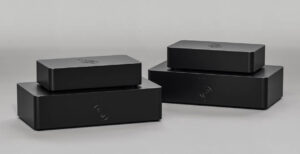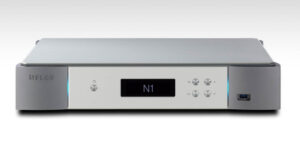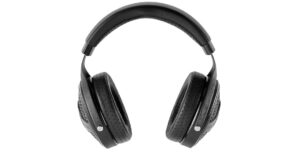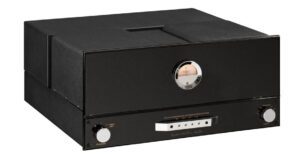
The full-function preamplifier has become something of a rarity, especially in the high-end, but Soulution’s 520 preamplifier – central to the company’s more ‘attainably priced’ range – sports an exceptionally capable moving coil phono stage in its single chassis. While this isn’t a preamp that bristles with inputs (phono stage aside, it has two balanced, and two single-ended inputs) and doesn’t sport anything close to a DAC, the minimalist 520 is still remarkably flexible by today’s standards.
Like the more upscale 725 line-stage, Soulution designed the 520 preamp to be an extremely wide bandwidth design – it’s only 3dB down at 1MHz – and places great emphasis on ultra-fast response times as a result. While we are not a measurement led magazine in any respect, a product claimed to sport a frequency response ruler flat to 200kHz, with less than -120dB of cross-talk and distortion so low, the analyser’s self-noise is more significant, deserves to be taken seriously.
The Soulution 520 achieves these figures by taking everything extremely seriously. Separate power supplies are used for the digital logic circuits and the amplifier stages, but these supplies are further fed through a multi-stage filter network, and the logic and amplifier stages are independently shielded to reduce the possibility of interference. The volume control is an 80 step, 1dB per step, precision foil resistor array instead of a potentiometer. This is selected via precision relays, but where most audio companies would ask the user to put up with the clicking of those relays, Soulution parallels a programmable gain amplifier as a separate volume path to function while the volume control is activated. Once the correct volume is set, this amplifier decouples itself from the signal path and the selected resistor pair kick in.
The MC phono stage has no gain adjustment (on the grounds that the 520 is quiet enough to accommodate the lowest gain cartridges without hitting the noise floor of the preamplifier), but impedance is set at the rear panel, using a series of DIP switches between the left and right channel MC inputs. The input ranges from 20Ω to 1kΩ in seven steps.

For a preamplifier that basically has one large knob and three small buttons on the front panel (the upper of which is reserved for ‘mute’ only, the lower being the power button), it’s surprisingly configurable. You can preset which source to start on, name those sources, the start-up volume level, the maximum and minimum volume levels, balance, screen brightness, activate ground lift (if there is hum), even whether there is a surround input and its optimum volume level. As the remote is passcode-bonded to the preamp, you might also need to reenter the remote’s ID, and that option is also on the front panel menu. Surprisingly, given the relatively limited range of input devices on the front panel used for menu diving (essentially the ‘prog’ button, pressing the volume knob, and turning the volume knob), navigating the options on offer is surprisingly easy, and the preamplifier with its big, friendly red LED readout is soon up and running.
Soulution is unfazed by whether the end user chooses balanced or single-ended connections between devices, although it recommends using the 520 with balanced designs for long cable runs. The 520 is inherently single-ended in design, and runs pseudo-balanced (rather than the other way round) so if you can follow the RCA route, so much the better. But not that much better, because the balanced pathway is remarkably close to the single-ended line, and with a 10Ω output impedance, virtually any cable made to practical lengths and any amplifier will partner the 520 perfectly. In other words, Soulution’s suggestion of cable architecture is more down to the company’s obsessive nature than any noticeable sonic benefit. And, unlike sorting your cornflakes by size before eating them, this kind of obsessive nature seems entirely beneficial.
This has to be read carefully, but Soulution is one of the least well-named brands in audio. The name suggests ‘soul’ and this is not the preamplifier for someone wanting something syrupy, soulful, and magical. Instead, this is the preamplifier for those seeking absolute realism, accuracy, and honesty. The ‘soul’ of this preamplifier is the soul of a musicologist or a tonmeister. This is the preamplifier for the person who is constantly berating the audio world for forgetting the term ‘hi-fi’ meant ‘high fidelity’ and demands a faithful reproduction of what is on the recording. In other words, there is no ‘soul’ in the Soulution… and that’s how it should be. If you misread this as a disguised insult, think about what the alternative actually means: you might want a bit of added seasoning to your music – some more ‘soul’ even – but what you add is also detracting from what was on the recording. The Soulution concept is an attempt to limit the artificial colouring and flavouring that seems to represent modern ‘high-end’.
That realism is not an easy thing to parse at first. It might show up components elsewhere in the signal chain. It doesn’t suffer musical fools gladly. And, perhaps most importantly, it might take time for the listener to come to terms with the lack of realism from what the Soulution 520 replaced. Some will listen and walk away, preferring their music with added sweeteners. Others will listen and walk away, only to return some time later having discovered the more realistic path is the right one after all.
In a way, however, Soulution is on the same path to musical realism that all the best of the best are taking, and the subtle variations between this preamp and the handful of similarly world-class designs out there are, in many cases, converging. Nevertheless, there is still a hint of accent in most audio devices, where the Soulution 520 seems to go for complete neutrality.
This neutrality makes the Soulution 520 both incredibly difficult and, paradoxically incredibly easy to write about. Part of the difficult part comes down to the way you have to waterboard the English language to express what it does, or rather what it doesn’t do. What you hear when trying to evaluate the Soulution 520 – more than perhaps anything this side of a passive preamplifier or maybe the late, lamented Pink Triangle Pip preamp – is the sound of other things. The detail levels are as good as the source component and as accurate as the power amplifier and loudspeakers will allow. The dynamic range is that of the recording, tempered through the medium of other equipment. The soundstage is defined by the recording and the speakers. Just when you think you have a handle on what the Soulution is doing sonically, you play another recording and the goal-posts shift again. It’s a seeming contradiction that a preamplifier that exemplifies the ‘straight wire with gain’ concept of a perfect amplifier is densely packed with componentry, but that is precisely how the 520 behaves.
Once again mangling the English language, the Soulution 520 is impressively unimpressive in performance. It adds practically nothing and subtracts practically nothing from the sound – even the outstanding, aforementioned Pip had its limits, and its bass didn’t quite extend down to the lowest registers, giving its neutrality a ‘stark’ quality if you partnered it with full-range designs. This makes pulling out musical examples almost pointless, because it simply reproduces the sound of the recording. And the way you can best determine this is the toughest test of all; listening to the way different recordings sound, rather than picking out individual aspects of a single recording. A different studio, a different engineer at the faders, different playing dynamics of session guitarists… moving from one recording to the next highlights just how accurate the Soulution 520 really is, because each difference is easy to pick up. Couple this with a Roon-ready source with all its music searching properties and you’ll not only be shown which recordings, say, Steve Gadd drummed on, but you’ll clearly hear when it’s Gadd playing and when it’s someone like Jim Keltner or Hal Blaine. You’ll know which studios use reverb chambers, which used springs, plates, or electronic reverbs, and the difference between an electronic reverb and a plug-in. These are subtle nuances, I grant you, but the kinds of subtlety that only come through when a product gets fully out of the way, and that’s precisely what the Soulution 520 does so well, both through its line stages and through that whisper-silent, excellent on-board phono stage.

With great power comes great responsibility, according to Spiderman’s Uncle Ben. And the Soulution 520 wields great power in audio. The great responsibility comes in with its care and feeding. Play a good recording and you’ll hear why it’s good; play a bad one and you might want to put out a contract on the producer. It’s unfortunate that we live in a time with so much good equipment and so many bad recordings, but the Soulution 520 takes few prisoners in the Loudness war. Compression is particularly vexatious to a preamplifier as fundamentally open and honest as the 520, and it lays such tracks bare. Fortunately, the worst excesses of bad sound seem behind us now, but a 20 year legacy of ‘everything louder than everything else’ recordings are rendered hard to listen through the 520. It’s not the preamp’s fault, but you have been warned!
The reason why many audiophiles bemoan the lack of good preamplifiers in comparison to similarly good sources, amplifiers, and loudspeakers, is that the preamplifier seems the one device that can make the system sound ‘grey’, ‘electronic’ and ‘artificial’. The other devices have their own imprint on the sound, but these can often be forgiven or even forgotten, but that fundamental ‘electronic-y’ sound comes into play, the overall performance is always compromised by that. This is part of the reason for the call of the passive preamp – no electronics, no electronics hash sound, no electronic-y sound. However, hope springs eternal for the active preamplifier that doesn’t append its own electronic-y character to music. No active preamplifier truly escapes this problem, but the Soulution 520 does get pretty close. In absolute terms, of the three strikes against active preamplifiers, the 520 does exceptionally well in reducing the ‘electronic’ and ‘artificial’ sound, and is very good at minimising that ‘grey’ presentation. But in relative terms, these characteristics are noticeable primarily by the absence, and we’re making room for the 700 series preamplifier to improve on the 520’s lot.
If there is a character to the 520 – and I stress the ‘if’ – it is a slight increase in image scale. There is a tendency for such things to be blown out of proportion in the reading of them, and “a slight increase in image scale” quickly becomes “the attack of the 50ft singer”. What this has instead is a sense of scale that is underpinned by extremely powerful bass; not overblown, fat bass, but bass with as clear a sense of purpose and honesty as the sound further up the midrange and treble. I don’t want to describe this as ‘grip’ because that implies a sense of control over the music the 520 simply refuses to add character in so obvious a manner. Instead it’s just honest bass delivered with the same sense of calm order and complete accuracy as heard throughout the rest of the frequency range. This does give the overall staging a more ‘majestic’ sense of presence that increases the size of the soundstage slightly.

If all of this is reading like the Soulution 520 is the best preamplifier I have ever tested, then it’s because it comes pretty damn close. I’m putting this up there with the handful of top preamplifiers I have ever heard, in with a very select few peers. Each has a different take on what it takes to be the best, and the Soulution’s sheer fidelity to what is on the recording is at once exhilarating, refreshing, and at times unnerving. But also extremely highly recommended.
Technical Specifications
- Type: full-function, solid-state preamplifier
- Inputs: 1× RCA pair (MC-only phono), 2× RCA pair, 2× XLR pair (line), proprietary Link system, RS232
- Outputs: 1× RCA pair, 1× XLR pair, proprietary Link system
- Input impedance: 3kΩ (RCA/XLR), adjustable 20Ω–1kΩ (phono)
- Output gain: –83dB to +16dB (unbalanced), –89dB to +10dB (XLR)
- Output impedance: 10Ω (RCA/XLR)
- Frequency response: 0Hz–800kHz
- THD+N: < 0.001%
- S/N Ratio: >120dB
- Crosstalk: <120dB
- Dimensions (W×H×D): 44.2×14.3×44.8cm
- Weight: 20kg
- Price: £15,000
Manufactured by: Soulution Audio
Distributed in the UK by: Select Audio
Tel: +44(0)1900 601954
Tags: FEATURED
By Alan Sircom
More articles from this authorRead Next From Review
See all
Reiki Audio SuperSwitch Master Pro + Servant Pro
- Mar 27, 2024

Melco Audio N1-S38 music server
- Mar 27, 2024

Focal Utopia 2022 headphones
- Mar 27, 2024











